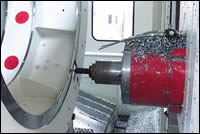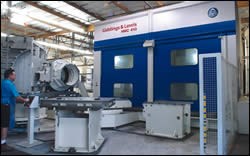HMC Reduces Precision Machining Time For Large Parts By 20 Percent
With the current glut of domestic manufacturing capacity and offshore competition, keeping a job shop competitive, particularly in these tight economic times, is not easy. For some shops, specializing in out-of-the-ordinary parts or niche markets is more lucrative than vying for highly sought after production runs of small parts.
Share




With the current glut of domestic manufacturing capacity and offshore competition, keeping a job shop competitive, particularly in these tight economic times, is not easy. For some shops, specializing in out-of-the-ordinary parts or niche markets is more lucrative than vying for highly sought after production runs of small parts. For example, Tapemation Machining Inc. (Scotts Valley, California) concentrates on precision machining of large components for the aerospace, defense, medical, scientific, electronic, marine and petroleum industries. Even with this specialization, machine tools must be maintained at peak performance all the time.
“We’re continually investing in the latest model, fastest and most accurate machines, so we operate at peak efficiency,” says Bruce Erickson, president. “Even a 10-year old machine is pretty much in the dark ages. We do high-end, difficult parts that companies are reluctant to send just anywhere or take off shore. Typically, our customers prefer to have their engineers keep an eye on these very expensive parts in a local shop. Most of the time, we do short-run production in lots of four to five. If you take 100 parts at five parts at a time, over a year, it adds up to a pretty good piece of business for us. But you must have equipment that can produce it efficiently; you can’t spend all your time setting up.”
Recently, Tapemation purchased a four-pallet HMC 410 from Giddings & Lewis (Fond du Lac, Wisconsin) with live spindle to increase productivity, flexibility and accuracy. The HMC features a four-pallet matrix, live (quill) spindle, through-spindle coolant, Siemens 840 control and 120-pocket automatic tool changer.
“The HMC 410, as equipped, offers us an HBM for tooling and prototype work and a machining center that allows minimum attendance machining during off hours for our production parts,” says Mr. Erickson. “Since large parts usually have several hour machining cycles, we can run two or three pallets during lights-out conditions several days a week and do other work requiring full attendance during normal shop hours.”
Balancing rush jobs and prototypes that require breaking down the current setup of production jobs is a problem common to job shops and manufacturers alike. It’s expensive enough to break into production runs of small parts, but the costs take on greater magnitude with large parts. The four-pallet matrix allows four fixtures for different jobs to be set up all at one time. Using a hoist, the pallet and fixture can be lifted off the matrix and replaced with another. The HMC 410 allows any of the pallets to be removed, not just the pallets from one station. Conceivably, a rack could be used to hold spare pallets with different fixtures, and it could be swapped in and out as needed.
“By loading and setting up the table off-line, we save about 20 percent over using a horizontal boring mill, which is what we compete against,” says Mr. Erickson. “With a horizontal boring mill, the table has to be cleaned off and the spindle is dead all that time. Since it’s not uncommon to take an hour or more for loading large parts into a fixture, the pallet matrix on the HMC saves a substantial amount of time loading parts while other jobs are running. Also, the 96-inch swing clearance of the rotary table allows the use of large or combined fixturing, which may be used for several parts of different shapes and sizes, reducing tooling costs on short-run jobs. This is significant for this type of work, saving leadtime and tooling dollars.”
Recently, Tapemation machined a large component for airport X-ray machines. The part is a welded steel fabrication that looks like a hexagonal nut welded onto a washer, only much larger. The circular plate diameter is about 54 inches; the hex is 30 inches across measured across the flat areas; and it stands about 30 inches tall. It is all hollow, so it can hold the X-ray tube and related systems and it rotates at 60 rpm in the assembly, so it has to be balanced.
A live (quill) spindle allows machining in tight places without the use of extended tooling. The live spindle on the HMC 410 is 130 mm diameter (5.1 inches), extends 800 mm (31.5 inches) and delivers 4,000 rpm with a 45 kW (60 hp) motor. A through-spindle coolant option flushes chips out of the way, reducing downtime for chip removal and enabling lights-out manufacturing.
“The live spindle makes it possible to machine this part without extended tooling and several extra fixtures and setups, which can be a problem when machining into all the areas of a large part,” says Mr. Erickson. “Without the live spindle, we’d have three or four operations, which is the way we did it before the HMC 410. Now, we have both operations on a single fixture, so the parts run two up. We eliminated a lot of fixturing and two operations because the size of the HMC 410 allowed us to machine all the way around the part, including drilling, milling, back-spotfacing and tapping rigid. So we have knocked four operations down to two.”
The Siemens 840D is a digital control featuring a 32-bit processor with a full-color 3D display and enhanced memory for fast and accurate axis control. Mr. Erickson said, “It has a tremendous amount of power that allows you to get a lot of efficiency out of it. The control requires a lot of training, but it will do more things and it has a lot more short cuts. Once you understand the control, you can really cut your cycle times down.”
When machining large parts, it’s not just turnaround time that’s important. Delivering an accurate part to the customer is equally important, which is why Tapemation has an internal quality control system that meets or exceeds MIL-I-45208A and uses laser calibration every 6 months to ensure the accuracy of its machining processes. As a Code-One flight item vendor for more than 40 years and an approved source for fracture critical, Level 1/Sub-Safe and high-strength steel components, Tapemation has a rigorous quality control program.
“We have the HMC 410 dialed into perpendicularity over the 72-inch cube out by about 0.0005 inch, which is pretty phenomenal for a machine that size,” says Mr. Erickson, “and linear displacement is dead on. We were really surprised at the accuracy of the machine. We have other HMCs in the shop, and we couldn’t get any of them anywhere near as close to the tolerances we can hold with the G&L.”
HMCs tend to be thought of as dedicated machines used by manufacturers for a part or family of parts. The HMC 410 is said to provide the speed, flexibility and accuracy to accommodate the production and quick changeovers required by job shops manufacturing large parts. The four-pallet matrix allows quick delivery of large parts for Tapemation’s periodic customers because the setup is on one of the machine’s four pallets.
“Normally, when somebody comes in with a large weldment or other part, they’re looking at a 4- to 5-week queue. If it’s a job we’ve done previously on the HMC 410, we can usually reduce the queue time to 2- or 3-weeks,” says Mr. Erickson. “The only way you can be competitive today is simply [to] have a piece of equipment that is superior to what the competition has, because the labor costs are pretty much the same across the board. You can get efficiency from equipment that will out-produce the other guys.”
Read Next
5 Rules of Thumb for Buying CNC Machine Tools
Use these tips to carefully plan your machine tool purchases and to avoid regretting your decision later.
Read MoreBuilding Out a Foundation for Student Machinists
Autodesk and Haas have teamed up to produce an introductory course for students that covers the basics of CAD, CAM and CNC while providing them with a portfolio part.
Read MoreSetting Up the Building Blocks for a Digital Factory
Woodward Inc. spent over a year developing an API to connect machines to its digital factory. Caron Engineering’s MiConnect has cut most of this process while also granting the shop greater access to machine information.
Read More



































